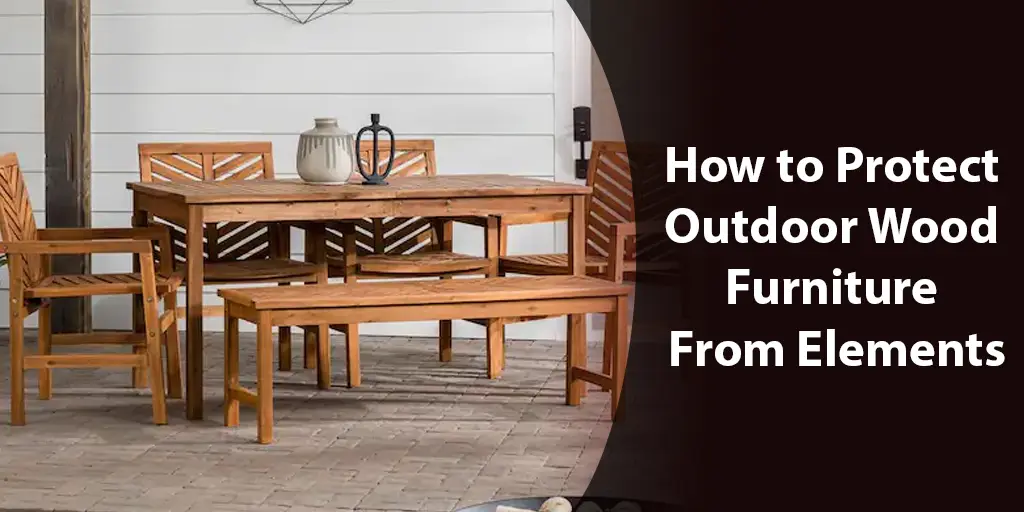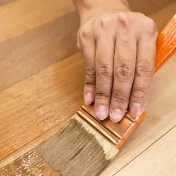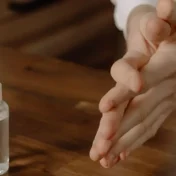Keeping your outdoor wood furniture looking its best requires the right techniques for protection. Whether enjoying relaxing evenings on the patio or hosting gatherings in the backyard, you’ve likely invested in high-quality wooden pieces that deserve proper care.

However, outdoor elements like sun, rain and temperature fluctuations can quickly damage untreated wood over time.
In this comprehensive guide, we’ll cover everything you need to know to shield your furniture from the unrelenting effects of nature.
We’ll discuss the characteristics of various wood types and how to prepare their surfaces for application. You’ll learn about the advantages of different protective finishes and how to apply them evenly for lasting results.
We’ll also provide tips for weatherproofing, routine maintenance, storage and preventing common issues.
Our extensive expertise has been tried and tested so you can protect your furniture with confidence. By following our step-by-step instructions and adopting sustainable practices, you can keep wood surfaces looking their best for years to come without hassle or mistakes.
You’ll discover proven methods for refreshing older pieces as well as innovative designs focused on durability.
Whether you’re new to wood care or an experienced enthusiast, we’ll answer your questions in clear, straightforward language.
Our comprehensive guide leaves no stone unturned, empowering you with the knowledge to preserve the natural beauty of your wooden furniture for many seasons of enjoyment.
Let’s get started on learning everything you need to know.
Understanding Wood for Outdoor Furniture
When it comes to choosing wood for patio or lawn items, not all species are created equal. Some withstand the elements far better than others.
In this section, we’ll break down the most popular options and what makes each better or worse for outdoor use.
Hardwoods like teak and eucalyptus top the list due to their natural resins, oils and density. Both repel water exceptionally well and boast resistance to rot, warping and cracking.
Their high oil content allows them to grey beautifully over time with minimal maintenance. These premium hardwoods offer excellent durability for high-traffic areas.
For furniture subjected to less wear-and-tear, softwoods prove versatile contenders. Cedar resists insects better than any wood thanks to natural oils that repel pests.
Its light coloring also hides dirt andgrime well. Redwood features good rot resistance while pine offers an affordable price point, though protection is paramount for both.
No material is entirely invulnerable, so choose species best matching your climate and design goals. Denser timbers last longer but cost more, while softer varieties demand Preventive measures.
Proper preparation and shielding using our techniques allows any wood type to survive inclement weather in style. With the knowledge of their inherent traits, you can confidently select pieces optimized for your needs.
Preparing the Wood Surface
Before applying any protective coating, it’s crucial to start with a clean, smooth base. This initial stage preps the wood to maximally absorb your chosen finish for strong and lasting results.
Begin by gently removing dirt, pollen and other debris using a mild cleaner or water. Never use harsh chemicals or abrasives which can damage fibers. Special attention should go to crevices where elements tend to linger.
Once dry, proceed to sanding using progressively finer grit paper, always with the grain. Lightly smoothing rough areas readies the wood for optimal penetration of your sealer.
Sanding also removes mill glaze, the glossy residue of machine finishing, allowing the wood to breathe.
Inspect for cracks or splits then fill using an exterior-rated filler which flexes with the wood. For minor nicks simply sanding may suffice. Don’t forget proofreading diagonal grain patterns too, sanding extra-slow and light there.
Lastly, wipe away all residual sanding dust with a tack cloth. This final cleansing removes contaminants so your finish strongly bonds to a uniformly textured surface.
Follow these expert preparation steps for furniture destined to gleam with health and protection for seasons ahead. Your wood will thank you!
Our clear guidance on these essential preliminary activities sets you up for long-lasting, flawless results to enjoy your outdoor living space worry-free.
Choosing the Right Protective Finish
Now that the wood surface is prepped, it’s time to select the ideal shield. While all finishes aim to repel water and UV rays, their unique compositions yield varying performance levels.
Oil-based finishes like linseed oil offer superb water resistance and bring out wood grain beautifully. They’re also natural and eco-friendly. Just be warned that oils require reapplication more frequently.
For vibrant color while protecting against spillage and wear, search no further than oil-based stains. Penetrating deep, stains fortify wood’s first line of defense. Choose a stain shade complementing or contrasting with your wood tone.
Acrylic-latex hybrids marry the best of oils and paints. Forming a durable film, they withstand abrasion and weather exceptionally well. Hybids also remain breathable and can be tinted attractive hues.
If shieldingRot-prone woods, opt for water-based polyurethanes. While creating a thicker shield, polys remain green and less toxic to apply than traditional varnishes.
Armed with our expertise on formulation differences, confidently opt for the finish type optimally safeguarding your wood’s characteristics. No matter your choice, proper sealing leverages nature herself on your furniture’s side.
Applying the Protective Finish
Now for the fun part – introducing your chosen shield to the wood using our master application method.
Correct technique ensures full coverage for supreme protection that will stand up to weather for seasons.
Start by stirring your finish vigorously and testing its consistency. For oils, maintain a wipe-on, wipe-off pace. Stains require more dwelling time – follow label instructions.
Apply in the direction of the grain using a high-quality synthetic brush with medium bristles. Load your brush fully but not excessively, then spread in long, even strokes free of excessdripping.
For the most flawless appearance, avoid over-application in any one area. Watch for missed spots and go over lightly if needed. Don’t attempt “evening out” by re-brushing as this may lead to an obscuring, mottled result.
Let each coat dry completely as directed before following up with additional layers for full defense. Resist the urge to hurriedly apply coat after coat. Patience delivers the superior outcome here.
Enhancing Weather Resistance
While a protective finish provides strong starting protection, additional barriers can further fortify your furniture against nature’s assaults. We reveal specialty tactics taking wood care to the next level.
UV damage breaks down wood fibers like nothing else. Combat it by applying water-based UV-protectant sealants in a thin, even coat. They chemically bond to cell walls, shielding from the sun’s deadly rays.
Moisture is wood’s enemy number two. Rather than repel water, modern water-repellent sealers form an invisible barrier seeping into every pore. This allows moisture to bead up and roll away, keeping furniture’s interior high and dry.
For furniture facing constant downpours, opt for a water-resistant coating fortifying the outer defense.
Formulated to excel where other products may falter, advanced sealants defend against repeat soakings better than nothing at all.
Following our tried-and-true methods secures truly impenetrable protection so you relax, confident harsh conditions cannot compromise all your faithful efforts.
Routine Maintenance
While protection provides peace of mind long-term, keeping coatings in top form demands diligent care. Our maintenance battle plan keeps your furniture appearing showroom fresh all season.
Start inside by dusting regularly using a microfiber cloth to gently lift away accumulated debris. For tougher remnants, mix a mild soap with water in a pump spray bottle – just a few spritzes does the trick.
Outdoor inspections scan for damage signs. Sand and reapply areas where the finish wears thin before problems arise. Rotting wood necessitates prompt repair or replacement.
Harsh climates mean reapplying finishes more frequently. Simply follow original application instructions each time for complete revival. Less drastic environments may only need touch-ups every 1-2 years.
Proper covering when not in active use is key – moisture trapped underneath accelerates deterioration. Use breathable covers fitted but not tight to allow airflow.
Armed with our expertise, confidently adhere to simple maintenance best suiting each unique environment and preventing expensive replacement down the line. Treat furnishings like family.
Storage and Care in Harsh Weather
While outdoor furniture adds immeasurable enjoyment to nice days, harsh weather demands preparation. Follow our guidance for safely storing pieces so they emerge from storms as magnificent as the day you bought them.
As temperatures drop toward freezing, thoroughly clean and dry all surfaces before fully applying fresh protective coats. This seals wood from moisture damage during inactive periods.
Where possible, stand furniture on its legs or edges within an insulated garage or shed. Elevating keeps wood from pooling water or wicking moisture from below. Ensure ample airflow and ventilation.
For larger items not feasible to relocate, carefully cover with breathable tarps securely fastened yet loose enough to allow airflow. Never use plastic! Trapped moisture breeds structural rot.
Deeper snowfall areas may require multipoint tarping or makeshift shelters. Block precipitation and sun yet permit air exchange to avoid condensation underneath.
With our expertise guiding strategic protection every step, you’ll retain beautifully maintained furnishings ready for renewed enjoyment come warmer weather again.
Preventing and Treating Wood Damage
Even with diligent protection strategies, damage occasionally occurs. Confront issues promptly using our know-how to arrest deterioration in its earliest phases.
Rot spells doom if ignored – however catch it early for positive outcomes. Look for discoloration, soft spots which “give” under pressure. Isolate with pruning shears and treat cut edges with sealant or fungicide.
Less advanced rot allows carving out and filling with exterior epoxy putty, effectively removing all infected wood. For furniture in peak condition, prevention is key via scrupulous maintenance preventing moisture intrusion.
Minor nicks and abrasions simply require light sanding and matching finish application. Neglect transforms these into trouble zones. Don’t spot-repair – seal the entire surface for uniform coverage.
Pests can also plague wood when care lapses. Identify invaders and remove using non-toxic methods before damage spreads. Harsh chemicals pollute and may erode prior treatments.
Staying vigilant lets us remedy any issues minor. Count on our expertise for reviving even seriously ill wood back to full health and longevity through the seasons.
Insect Prevention and Treatment
While well-maintained wood enjoys less pest problems, it’s wise planning for potential invaders. We reveal secrets thwarting the most persistent infesters.
Wood-boring beetles relentlessly attack untreated surfaces. Prevent entry by fully sealing end grains plus routinely inspecting for egg galleries – fine serpentine tunnels. Scrape and fill these prohibited areas.
Termites also target wood lacking preservatives. Establish a chemical soil barrier or use non-toxic diatomaceous earth to disrupt their paths. Regularly monitor for mud tubes too.
Ants follow pheromone trails, so thoroughly clean up food sources or use baits to safely eliminate existing colonies nearby. Don’t forget furnishing gaps where they may nest undisturbed.
For active infestations, amably encourage insects to relocate using plant-based sprays. When absolutely necessary, spot-treat severe damage with targeted, EPA-approved solutions.
Our intelligence promises peace of mind whether avoid bugs proactively or resolving minor issues humanely. Well-protected wood means healthy habitats for all.
Additional Protection Options
While protection mainstays guard strongly, further clever implementations yield unrivaled defense. Discover novel tactics reinforcing your multi-layered safety net.
For high-use tables, a removable tablecloth made of breathable fabric provides an effortless extra barrier against spills and chips. Simply launder soiled covers for quick cleansing.
Casual furniture arranged spontaneously merits portable breathable dust covers allowing quick deployment during bursts. Stow neatly when sun returns.
Sheltered alcoves constructed simply of a waterproof fabric like canvas tied to posts refrain expensive materials. Angle roofs to direct flows.
Innovative designs like slatted benches permitting drainage or all-weather wicker and rattan sidestep worries altogether. Supply thoughtful backup for rare storms.
Our expansive protection palette caters solutions for all tastes, budgets and changing situations. Layer judiciously and appreciate furnishings enduring through challenges with continued good looks!
Maintaining Appearance Over Time
While protection preserves the structural integrity of wood, small interventions keep surfaces peering their polished best. Learn techniques restoring ravaged patinas or enhancing naturally aged tones.
For fading, lightly sand and re-stain impacted regions, feathering edges. Two thin coats yield richer color without buildup. Match shade or opt lighter/darker for intentional distressing.
Minor cracks may be filled using putty or rope caulk dyed to match existing grain. Take care applying, sanding seamlessly post-cure.
Scratches invariably occur. Scuff out minor mars by rubbing along grain with fine steel wool dipped in stain or oil. Deeper gauges require more sanding beforehand.
Periodic polishing with boiled linseed oil or wax revives rusticity. Buff vigorously in direction of grain, removing oxidation, water spots while conditioning fibers.
Common Mistakes to Avoid
Protecting wood furnishings requires some specialized knowledge to avoid common pitfalls ruining efforts. Learn from our experienced mistakes so your projects excellence ensure.
Rushing preparation leads to uneven protection. Take time sanding smoothly and removing all debris to allow an ideal bond with the finish.
Harsh cleaners and coarse abrasives damage delicate wood fibers, ironically weakening its structure. Stick with gentle solutions.
Incomplete drying between finish coats promotes runs and obscuring. Follow product directions for fully curing layers.
Over-application forms a diminished protective film prone to peeling. Go light, building coverage over multiple thin skims.
Exposed end grains wick moisture unless sealed, accelerating interior rotting. Don’t forget wood’s vulnerable zones!
Neglect permits damage spreading requiring replacement, when minor issues were preventable with attentive maintenance.
Consult our guidance and avoid regrettable mistakes. Protect wood furnishings holistically for enduring natural beauty and structural integrity.
Refinishing Old Furniture
With age, even the sturdiest protection degrades, leaving beloved patinated pieces vulnerable once more. Revitalize furnishings to enjoy for further seasons with our refinishing process.
Start by thoroughly inspecting wood for rot, flaws requiring filling or replacement first. Make repairs as knowledgeable professionals would.
Gently strip old finishes chemically, avoiding abrasives which alter the material. Remove layers back to bare wood ensuring ideal bond with new protections.
Lightly sanding refreshed surfaces smooths while removing mill glare, oxidation for a neutral palette. Wipe away all residue.
Reseal end grains to arrest future water damage there before applying your selected revitalizing finish as previously instructed.
Consider an aged stain complementing hard-earned character instead of outright paint removal. Or refinish naturally for renewed protection.
Condition with natural oils emphasizing grain, then polish for luminous sheen. Admire revived beauty, now shielded for another lifetime!
Confidently restore what you cherish to as-new or enhanced status through our expertise maintaining history and value in one.
Sustainable Practices
While protecting what you love, consider the larger impact through environmentally-conscious choices. Our insights minimize footprints.
Whenever possible, opt for plant-derived finishes like linseed oil requiring no petrochemicals. They also condition wood naturally for superior longevity.
Avoid harsh preservatives leaching into soil or groundwater. Use non-toxic options if pests emerge or plant resistant species initially.
Properly dispose or recycle all empties, brushes, rags and materials according to local hazardous guidelines. Keep toxins out of lands, streams.
Consider leaving some woods untreated for wildlife relying on natural decomposition cycles. Balance needs with ethical stewardship.
Rather than replacement, refinish items using environmentally-safe stripping and revised protective coats. Breathe new life into pieces sustainably.
Green practices maintain equipment, resources and natural beauty for generations to come. Make informed choices keeping forests and furnishings healthy.
FAQs
This section addresses some of the most common questions we receive about outdoor wood furniture protection.
Q: Can any type of wood be used outdoors?
A: While many wood species can withstand outdoor use with the proper care, hardwoods like teak are more durable due to natural oils and density. Softer woods require more maintenance. Choosing the right wood for your climate is key.
Q: How often should I reapply a protective finish?
A: Reapplication frequency varies depending on wood type, environment, and level of wear. High traffic areas may need yearly coats while vertical or covered surfaces can go every 2-3 years. Inspect annually and reapply if the finish has cracked or worn away.
Q: Can indoor furniture be used outdoors temporarily?
A: Indoor furniture isn’t designed for outdoor exposure. However, with protective treatment like an outdoor sealant applied beforehand and prompt storing indoors after use, temporary outdoor use is possible on dry days. Don’t leave untreated indoor furniture exposed long-term.
Q: Can I protect wood naturally without altering the look?
A: Yes, plant-based finishes like linseed or tung oil protect wood while bringing out the grain without paint-like coverage. Multiple light coats allow the wood’s texture and character to shine through while guarding against weathering. These natural shields require more diligent reapplication.
Q: Are there natural DIY alternatives to chemical finishes?
A: Yes, simple homemade mixtures combining natural oils with solvents provide protection without harsh chemicals. Popular formulations use linseed, mineral or citrus oils combined with natural wax or resin to nourish and weatherproof wood in an eco-friendly manner. Experimentation is required for balancing protection efficacy.
Conclusion
With diligent care informed by the expertise and techniques outlined in this guide, your outdoor wood furniture can thrive for many years of enjoyment.
From initial material choices and surface preparation, through application of tailored protective coatings and prudent seasonal routines, following our guidance ensures furniture is fortified against all that nature throws its way.
For those with inherited pieces wishing to restore their patina, or looking to invest in furnishings built to withstand climate extremes, the methods covered here restore wood to as-new condition or maximize innate durability.
Sustainable practices keep treasured materials circulating within the natural world harmoniously for generations of families.
Whether addressing tiny flaws before they spread or transforming tired remnants into future heirlooms, the knowledge gained equips you to preserve what you love confidently.
Outdoor living areas maintained this way offer relaxed, worry-free spaces for recreation through any weather.
We hope you now feel empowered to shield outdoor wood surfaces comprehensively and learn from our expertise emerging as seasoned stewards.
With continued care as outlined, furnishings will age beautifully in form and function for years of enjoyment and memories. Apply these techniques to protect your investment for decades ahead.



